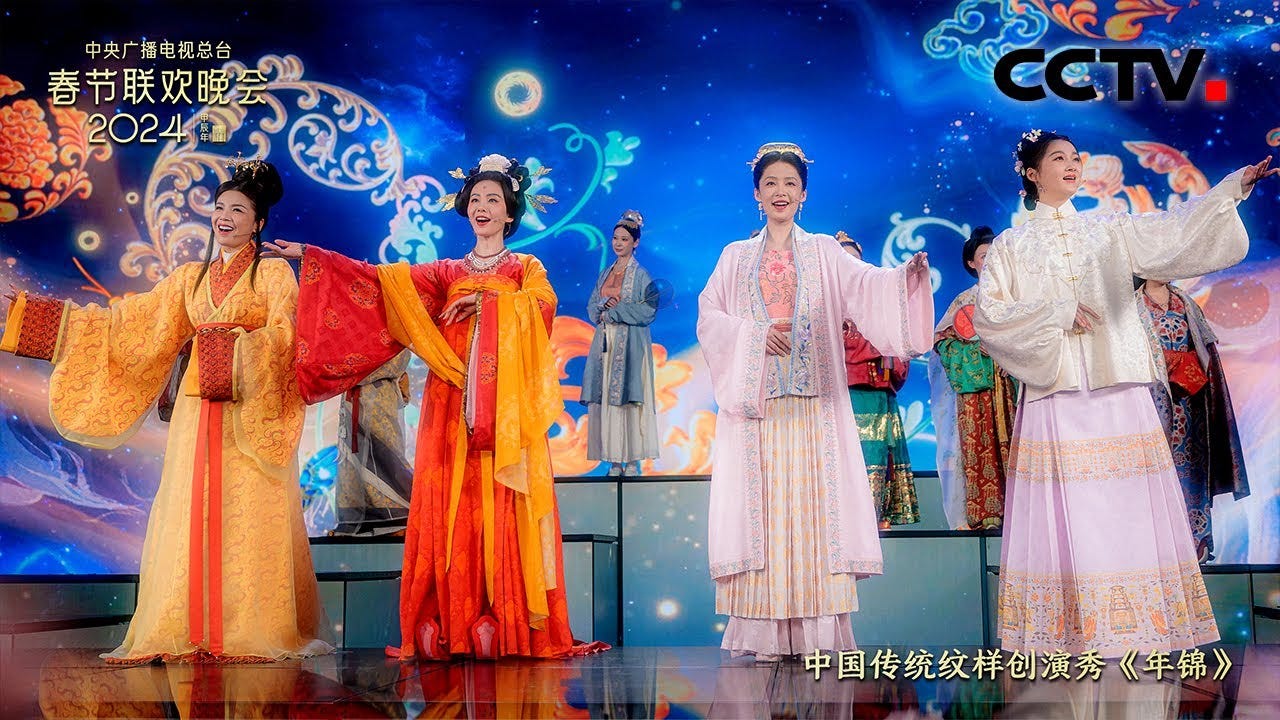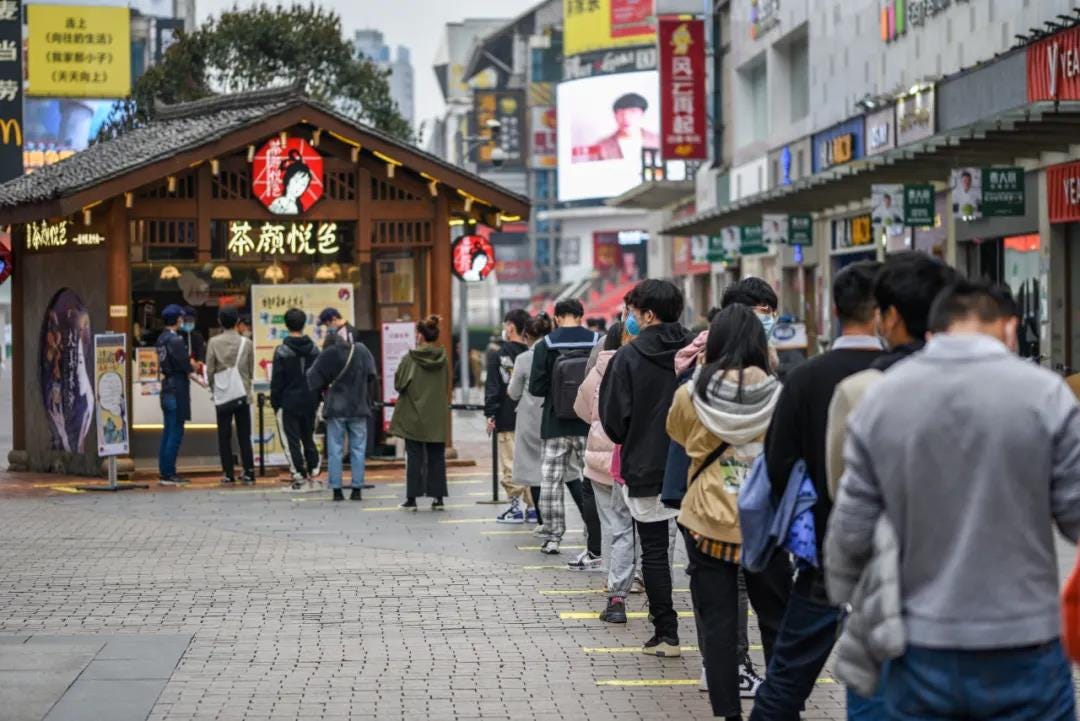04. In With the Old
How a revival of the classics tie entertainment, culture and politics together
Hi there. Welcome to Active Faults.
My take on this year’s Spring Festival Gala (春晚) coincidentally echoes this ChinaTalk review of it: it actually wasn’t that bad. Whoever directed it dialled down the propaganda and, in my opinion, used an old trick that turned it into something far scarier. A softer, more inconspicuous but just as unrelenting rendition of pro Party-State narratives delivered through a detour.
Today, let’s dissect an interwoven blob. How do “cultural exports” (文化输出), domestic tourism, entertainment, provincial governance and politics act on each other?
Instead of drowning you with scalding hot water, this year’s Gala was a warm bathtub of nationalistic discourses that swaddles and beguiles you. For starters, its side shows in Kashgar, Xinjiang UAR feel like such a deliberate showcase of prosperity and peace to me. It was hard to sit through that segment which basically says these people here are unharmed and grateful, so you should be too. Like
mentioned, one of the most successful Uyghur actresses, Dilraba, was part of the main performance. I talked about this in the first few issues of this Substack: entertainment in China is a weapon and a distraction. Celebrities are manipulated into appealing mascots to spread a certain message and achieve an end, while acting as a buffer lest the public looks behind the facade.On the other hand, many have noticed the scarcity of “语言类节目” , talk-centric performances in the Gala like skits and Xiangsheng. Instead, the Gala this year went heavy on musical and dramatic arts, such as dances, operas and songs. A Weibo post pointed out the obvious:
Because language is a manifestation of opinions and an expression of will, and resonance is a destructive flood. It is sharp and dangerous. [Talk-centric performances] are doomed to die out in today’s atmosphere.
So, the Gala serves up pretty people lip-syncing to China-styled (中国风) tunes and dancing in elaborate traditional attire, applauded by a paid-acting crowd.
These performances are somewhat products of fierce competition. Each year, provincial TV channels would produce their own 春晚 with localised characteristics, specifically tailored for their home base. Beijing TV normally packs the schedule with Beijing Opera, while Liaoning TV nurtured generations after generations of Dongbei comedians (like the famed Zhao Benshan) with their skits in dialects. Since the reputation of CCTV’s main show has deteriorated to such unsalvageable extremes, regional channels have attracted substantial public attention which led to their rescheduling of the Galas and avoiding direct clashes with CCTV. The main act probably felt petty, because provincial channels are much more likeable. No reiterations of the Top Dog’s school of thought and lectures on the importance of giving birth to three children. Entertainment can be partially restored to its purest form: to spark pleasure and laughter.
One of the most prominent competitors of CCTV was Henan TV. Being the birthplace of Han Chinese civilisations and the home to 4 out of the 8 ancient capitals of China, the provincial channel pioneered several viral performances like 唐宫夜宴 in 2021. It is a reenactment of a banquet night during the Tang dynasty, where a group of female dancers played the courtesans. The 5-minute long dance has a complete narrative arc, showing both lavish court scenes as well as Tang people’s daily lives and banters. Using classical paintings as backdrops, it is cleverly edited as if the artworks came alive.
It was hailed as an “effective cultural export” (有效文化输出). This kind of aesthetically pleasing spectacles is what the public wants to see and tell foreigners about.
When placed side by side with what CCTV offered that year, the comparison was brutal. It prompted the latter to try and jump on the bandwagon, both to win back the majority’s favour and re-strategise propaganda by exploiting the classics. Pre-PRC history is richer and easier to tell positively as a good “China’s Story”. As propaganda, it sounds less harsh to the ears and will also distract the public from the current oppression. “只此青绿” thus came about, as well as similar segments in this year’s broadcast.

Productions like these took inspiration from, and then spurred on, a general revival of the classical style (古风) in recent years. There’s been an emergence of Hanfu (汉服) enthusiasts, who buy, collect and wear garments adapted from styles in dynastical times. You’d hear about 古风 in the latest music, TV series, movies, and more. There’s Wei Daxun’s fan edit as the New Chinese-styled CEO, the rise of Forbidden City merch (故宫文创), or the frequent reruns of 甄嬛传. Too many examples can be listed, among them even milk tea stores.
Arguably the most hyped-up milk tea chain in China right now is the Hunan-based 茶颜悦色 (jarringly named Sexy Tea), which advertises itself as a “modern China tea shop” with notorious queues. Exclusively sourcing Chinese tea leaves and expertly naming every drink with a 古风 descriptor (taken from Chinese poetry or paintings), 茶颜悦色 blew up because it caught the right change of wind.
They also cracked the secret of consumerism, where you should sell a concept and not the product. They’ve opened branches in heritage buildings, collaborated with a Dream of the Red Chamber production crew, and organised discount fests that are called “masters’ fest” (小主节). They’ve taken the archaic term used by servants for their concubine masters in a royal palace as their official way to address their consumers. With such marketing choices, 茶颜悦色 consolidated its brand image as a propellant and advocate for traditional cultures (传统文化), striving to strengthen the public’s sense of cultural pride. How’s the tea itself, you ask? Me and my friend tried everything on the menu while we were in Changsha, and I can begrudgingly admit they were pretty good.
I might save the outlining of Chinese milk tea’s genealogy for another day and in another section (have you heard about the non-AF corner of AF?). But I’m not surprised that the roots of 茶颜悦色 lie in Changsha, where a memorial of Mao is still a tourist attraction in the city centre. It is no surprise either that CHAGEE (霸王茶姬), 吃茶三千 and 隆延茶铺, the newest milktea chains on the block all got a 古风 brand image. A mass return to the classics is not as organic as it seems, and nor is it safe from exploitation.
Look towards tourism. Xi’an has built the famed 大唐不夜城, where a 2km long promenade cuts through a replica of a Tang capital. Visitors find themselves enlisting the services of a travel photography agency (旅拍) where a professional photo-op can be carried out. You pay for a package that includes costumes, hair & makeup, a photographer who takes you around the most photogenic spots, and leave with an edited portfolio of photos ready to post on social media. In historical sites, the token attire would be a 古风 look to fit the vibe. I’ve seen my friends and their elaborate cosplays in Hangzhou, Nanjing, and anywhere with ancient architecture. In places where there’s an ethnic minority like Yunnan, Tibet, Guizhou and Yanji, the equivalent is traditional ethnic looks in front of natural sceneries.
Where a standard 旅拍 package visit is normally 打卡点, “check-in” spots, meaning must-visit photo spots. In fact, 旅拍 and “check-in” culture on social media are like a problematically codependent couple, where the outburst of one will stimulate the other. As more photos get taken, more tourists would want to check in there and so on. I urge you to ponder the implication of this culture to social media pipeline. The one and only purpose of these photos is to appear on the internet. Distinct cultural phenomenons, old and current, are reduced to factory line snapshots and “trends”. Customs and practices become talking points and “hot topics”, like the bathhouse culture in Dongbei or the religious rituals of the Hakkas in Fujian in the past months.
Provincial governments are protecting and encouraging that pipeline. Their online presence has been subjected to a lot of criticism this year, where this scathing Vista article basically called the tourism bureaus boomers who are pretending to be cool but failing. It also pointed out one thing: collusions between celebrities and provincial governments to boost domestic tourism are becoming much more obvious. Some are made official, like how Wen Junhui, the Chinese member of SEVENTEEN became a tourism promoter for Shenzhen.
Some are less direct influences. When I visited Xiamen last month, I was informed by my taxi driver that I should get my hair styled at this one traditional parlor for some photos, because Zhao Liying the actress was there. She dressed up as a 蟳埔女, a woman from a seaside town in Quanzhou, Fujian whose daily attire consists of a specifically designed flower crown (簪花围). Her fans were eager to assert that this cultural practice and the local economy was successfully revived because of Zhao’s visit (簪花围 shops increased from 7 to more than 200). She’s a truly 正能量 celebrity raising awareness for a nationally recognised intangible cultural heritage, who’s even mentioned by 学习强国 (A mobile app that teaches Xi’s school of thought).
On Xiaohongshu, you’d see compiled lists of restaurants, sites and shops that are 明星同款 (celeb-visited) in any town. Governments catch onto that, and sometimes ask celebrities to film promotional videos. Fans actively perpetuate the discourse from there on, praising their idol for protecting cultures and being socially aware. An involution has begun as to which celebrity is more loyal to their hometown. People say that Henan won by a mile because Wang Yibo has been proudly declaring his lineage since years ago. Others argue that Zhu Yilong donated several hundred thousand worth of medical supplies to Wuhan during the pandemic. Zeng Shunxi, an actor from Shenzhen just sang on CCTV’s Gala in Cantonese about how noodles are prepared in his hometown.
And here we are. Centralised propaganda encourages and relies on regional cultural exports, which manifest in and stimulate tourism supported by social media that celebrities have the power to sway, who are controlled by and participate in spreading centralised propaganda. We’ve come full circle.
Some fandom studies on China tend to treat the phenomenon in a vacuum, especially those conducted by Chinese scholars. That can’t be further from the truth. It is always interacting with various forces and the wider context. What I’ve written in the last paragraph is also not a linear, uniform feedback loop representative of the whole picture, but one legible thread that I chose to pull out. If there’s anything I want to get through to you in AF it’s this: fanquan is never just about fanquan.









Just want to say that this was really enjoyable read, and you really hit on some of the things that I find mildly disturbing about Chinese social media and marketing, like tokenism, 打卡ing, etc. Not that it doesn’t exist here in the west, but idk, sometimes I feel like western social media doesn’t have as strong convergence (towards one thing) as Chinese social media